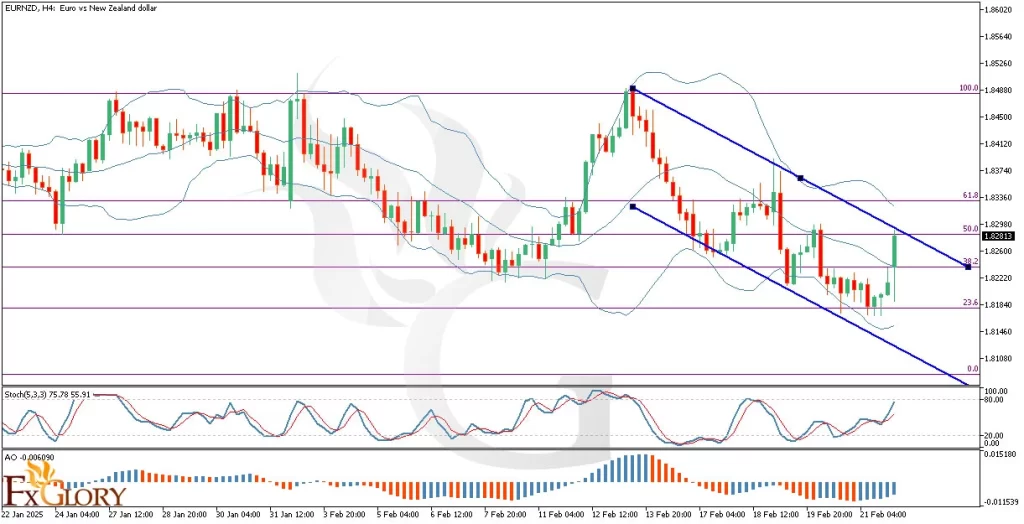Time Zone: GMT +2
Time Frame: 4 Hours (H4)
Fundamental Analysis:
The EURNZD pair is experiencing market volatility as traders react to key economic data from both the Eurozone and New Zealand. The IFO Business Climate Index from Germany, a leading indicator of economic sentiment, is expected to provide insights into the strength of the European economy. A better-than-expected reading could boost the Euro (EUR), while a weaker-than-expected outcome may pressure the currency. Additionally, the upcoming Core CPI and CPI reports from the Eurozone will significantly impact inflation expectations and influence the European Central Bank’s (ECB) monetary policy outlook.
On the New Zealand dollar (NZD) side, recent Retail Sales and Core Retail Sales reports reflect consumer spending trends. Since these are lagging indicators, their impact may be limited unless there is a significant deviation from expectations. The Reserve Bank of New Zealand (RBNZ) continues to monitor inflationary pressures, and upcoming credit card spending data will provide further clues on consumer activity. If the data signals a robust retail environment, the NZD may gain strength.
Price Action:
The EURNZD pair has been in a downward channel since reaching a peak in mid-February. However, the last four candles have been bullish, indicating a potential short-term reversal or correction. The price has swiftly moved from the lower Bollinger Band to the upper band, breaking through the middle band in a single strong bullish move. Additionally, the EUR NZD price is currently testing the 50% Fibonacci retracement level, which serves as a key decision point for traders. If buyers maintain momentum, the next resistance level could be challenged. Conversely, if selling pressure resumes, the downtrend may continue.
Key Technical Indicators:
Bollinger Bands: The EURNZD price has moved from the lower Bollinger Band to the upper band, signaling increased volatility and a potential breakout from the bearish channel. Despite the overall downtrend, this sudden price spike suggests that bulls are regaining some control. If the price holds above the middle band, further bullish movement could be expected.
Stochastic Oscillator (Stoch 5,3,3): The Stochastic Oscillator is currently near the 75-80 zone, indicating that momentum has shifted towards the bulls. This suggests that the EUR/NZD pair might enter overbought territory soon. However, if the %K and %D lines cross downwards from these levels, a potential pullback may occur.
Awesome Oscillator (AO): The AO histogram has transitioned from deep red to light blue, indicating weakening bearish momentum. While the histogram remains negative, the current trend suggests that bullish pressure is increasing. If the AO crosses above the zero line, it would confirm a stronger upside move.
Support and Resistance Levels:
Support: The nearest support level is at 1.8180, aligning with the 23.6% Fibonacci retracement level and recent lows. If the EURNZD price breaks below this level, further downside movement could follow.
Resistance: The immediate resistance is at 1.8290, corresponding to the 50% Fibonacci retracement level. A successful breakout above this level could lead to a test of 1.8330 (61.8% Fibonacci level).
Conclusion and Consideration:
The EURNZD H4 chart analysis suggests a potential short-term bullish correction within a broader downtrend channel. The recent bullish momentum, reflected in Bollinger Bands, Stochastic Oscillator, and AO, highlights a possible upside continuation if resistance levels are broken. However, traders should remain cautious as the overall trend remains bearish unless a significant breakout occurs. Key fundamental factors, including IFO Business Climate Index, CPI data from the Eurozone, and New Zealand’s retail sales, could drive volatility in the EUR-NZD pair. Traders should closely monitor these reports, as unexpected economic data could shift market sentiment rapidly.
Disclaimer: The analysis provided for EUR/NZD is for informational purposes only and does not constitute investment advice. Traders are encouraged to perform their own analysis and research before making any trading decisions on EURNZD. Market conditions can change quickly, so staying informed with the latest data is essential.






